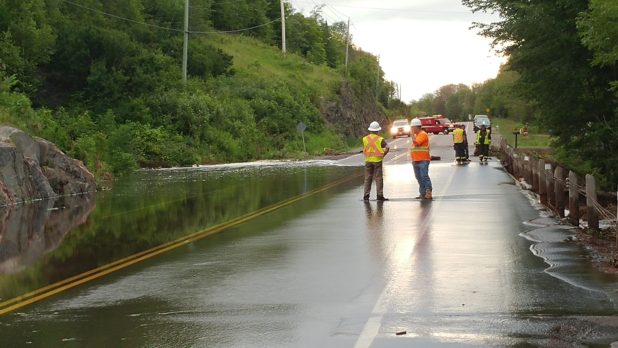Headline News
Beaver dam monitoring landowners’ responsibility
July 20, 2017

Hwy 28 South was shut down with no way through after beaver dams burst and flooded the highway from a nearby lake. / SARAH SOBANSKI Staff
By Sarah Sobanski
Damages caused by bursting beaver dams could fall to you. That’s according to the province, but it’s up for some debate between local works managers, the Ministry of Natural Resources and Forestry, and the Ministry of Transportation.
On May 2, Hastings Highlands operations manager Adrian Tomasini says one beaver dam blowout led to another until five consecutive dams had burst. Lake St. Peter Road was washed out. Tomasini says if the municipality had contracted out the roads work, repairs could have cost upwards of $80,000.
Two more beaver dam related washouts occurred in late June, one on Hwy 118 west of Cardiff, the other on Hwy 62 when Moore Lane was swept away. Both instances had works crews working well into the night.
Last week, dams burst on Port Hope Lake. The rushing water cut off Hwy 28 South for more than a day, causing commuters to detour McGillivray Road to Inlet Bay to Hwy 118.
Dam blowouts are happening more frequently this year compared to last year, after a heavy snow and then rain season. If a dam blows on private property, it can not only cause damages to other private properties, but to Crown and municipal properties as well.
Local works managers and the MNRF, however, suggest there is no framework or legislation for private property owners to monitor dams on their properties. Nor is there for anyone else with the expertise to do so such as municipal works staff — but responsibility can’t fall to the beavers.
“If you see a beaver actively blocking your waterways, you have to make sure [it’s monitored] because technically the landowner could be responsible for the blowing out of that beaver dam,” says Tomasini, whose staff regularly pulls dams from municipal culverts. “You are liable for the damage that the beaver dam causes if it’s on your property.”
He added, “I don’t know of an incident where anyone has come back to a private landowner and done that, because technically waterways are also owned by the ministry. The municipality doesn’t own any lakes or rivers and neither does any private landowner — it’s just across your property. A water system is controlled by the MNRF.”
The Fish and Wildlife Conservation Act states a person shall not damage or destroy a beaver dam unless the person holds a licence to trap furbearing mammals. This doesn’t apply to a person or agent who damages or destroys a beaver dam to protect the person’s property.
“The [MNRF] is not responsible for monitoring beaver dams or the damage they may cause. Where property or infrastructure is threatened by beaver dams, the property owner [for example the] homeowner, municipality [or] Ministry of Transportation, is empowered to manipulate or destroy beaver dams in order to protect their property as needed,” writes Jolanta Kowalski, senior media relations officer for the MNRF. “There is no prior approval required by these property owners to enter on to Crown land to destroy a beaver dam in protection of their property.”
The property owner should perhaps monitor dams on or around his or her property as a good steward, but isn’t legally obligated to. However, he or she may be held liable according to one Government of Ontario website.
On the government’s site, the article “Preventing conflicts with beavers,” gives a number of ways to clear beavers from your property such as planting elderberry or painting tree trunks with a sand and paint mixture. It also gives tips on how to remove a beaver dam but states “you may be held liable for any property damage that occurs downstream.”
According to the article, the property owner should “exercise extreme caution to prevent downstream flooding, damage to natural habitats and property damage” when removing a dam. It also recommends calling the MNRF for advice on how to control water levels.
“It’s a delicate situation because nine times out of 10 beaver dams are on private property and if we are not aware of them — in most cases we aren’t like the washout up on [Hwy] 62 North — we can’t control what happens on private property,” says Bancroft works manager Perry Kelly, noting the question of who foots the bill with so many recent washouts is on everyone’s mind.
“The problem is that it creates a huge liability on the municipality… Unfortunately, it’s up to the property owner to maintain. If they have a watershed on their property, they need to maintain that watershed themselves. They are the ones that are ultimately responsible, not the municipalities, not the MTO, whoever owns that property. The property owner is responsible for maintaining the level of the water, maintaining their beaver dams and looking after their own assets.”
That said, the Ministry of Transportation told Bancroft This Week it would not require a property owner to cover the cost of the repairs for washouts of provincial highways.
At the end of the day, in order to ensure that highway washouts — which can cost municipalities or provincial ministries hundreds of thousands of dollars — aren’t caused from beaver dam blowouts, property owners need to monitor dams on their properties.

















